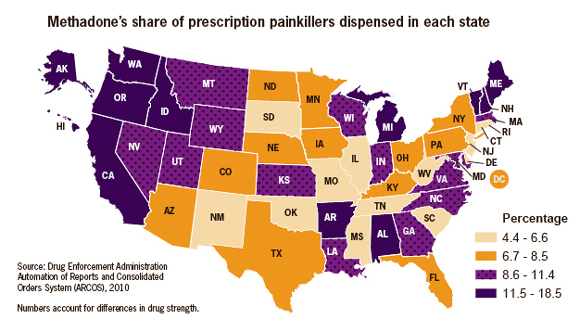Methadone is an opioid medication most commonly used for detoxification, maintenance treatment of opioid addiction, and limited use for chronic pain. The drawbacks to its use stem from the risk of addiction and abuse with the medication, even at recommended doses. Alarmingly, the Centers for Disease Control and Prevention (CDC) found that methadone is responsible for 30% of all opioid overdose deaths, despite the fact that it only accounts for 2% of opioid prescriptions. [1] Why are we seeing this trend and what can we learn about methadone’s risk factors to help increase awareness and patient safety?

Methadone has complex pharmacokinetics which results in a significantly longer half-life. The way it is processed by the body makes its pain relief duration much shorter than the length of time the drug remains in a person’s system. This requires the dosing three times a day, making the drug’s concentration build up in the body at a faster rate. The chronic dosing of methadone causes it to accumulate in the patient’s tissues, taking longer for the drug to be eliminated from the body and causing the tissue to slowly release methadone into the blood. This also makes the morphine equivalent dose of methadone increase at an exponential rate as subsequent doses are taken.
In a claim recently referred to Sedgwick’s clinical team, a patient was utilizing methadone for chronic pain. The patient was also taking Xanax for anxiety, oxycodone for breakthrough pain, gabapentin for neuropathy and cyclobenzaprine for muscle spasms. Individually, these medications might not draw alarm, but when we look at the therapy as a whole, there is great cause for concern. Along with the many adverse events that can be posed by methadone’s kinetic properties, methadone is associated with multiple drug interaction issues, due to it being metabolized extensively by liver enzymes. Using methadone in connection with alcohol, benzodiazepines (Xanax), antidepressants, barbiturates and other opioids (oxycodone) puts the patient at high risk for drug-related adverse reactions, such as respiratory and central nervous system (CNS) depression. The U.S. Food and Drug Administration (FDA) issued a “black box” warning in the summer of 2016, alerting physicians and patients against the combined use of any opioid and benzodiazepine due to the serious risks associated with their use.
Drug interactions are not the only thing we have to consider when dealing with methadone. The patient’s comorbidities can also pose complications. In the same case as noted above, the patient has sleep apnea, high blood pressure and is a current smoker. The drug interactions for the patient alone put them at risk for respiratory depression, but when mixed with comorbidities of sleep apnea and smoking, the risk for a negative outcome is far greater. Other comorbidities, such as cardiovascular disease, contribute to potentially fatal consequences, including CNS and respiratory depression, and cardiovascular effects such as swelling and QT prolongation, impacting heart attack risk.
This patient’s case may seem to be an outlier due to its complex drug interactions and comorbidities, but this is actually a common occurrence with patients escalated to methadone. Even with the dangers of methadone, it is becoming more popular to treat pain, partially due to its inexpensive cost compared to other opioids. Caution should be exercised when dealing with this medication, as there are clearly many variables that need to be examined to ensure the patient’s safety.
Dr. Andrew Newhouse, Sedgwick pharmacist
Reference:
- Trends in Methadone Distribution for Pain Treatment, Methadone Diversion, and Overdose Deaths — United States, 2002–2014 CDC / Morbidity and Mortality Weekly Report / July 8, 2016 / 65(26);667–671